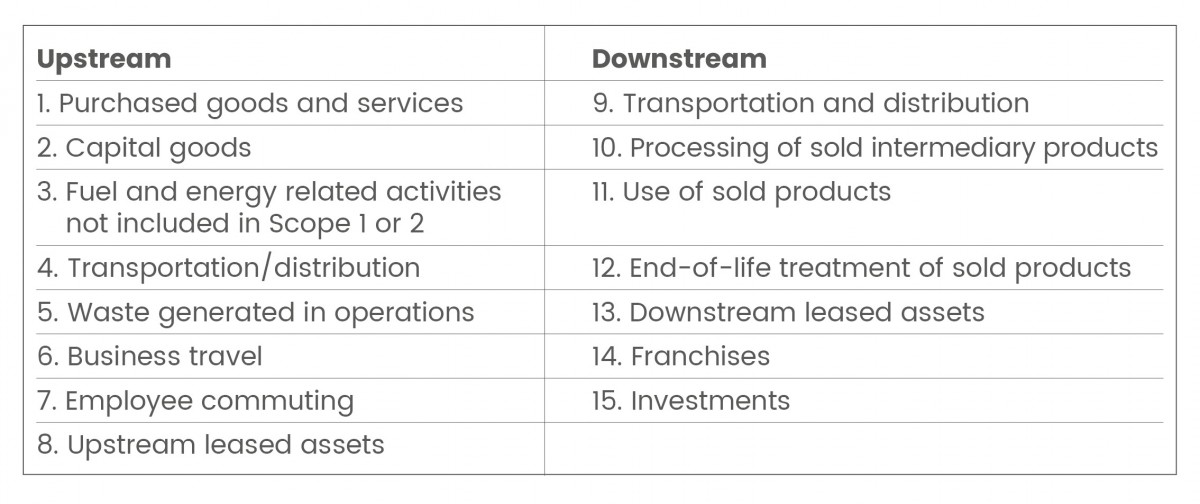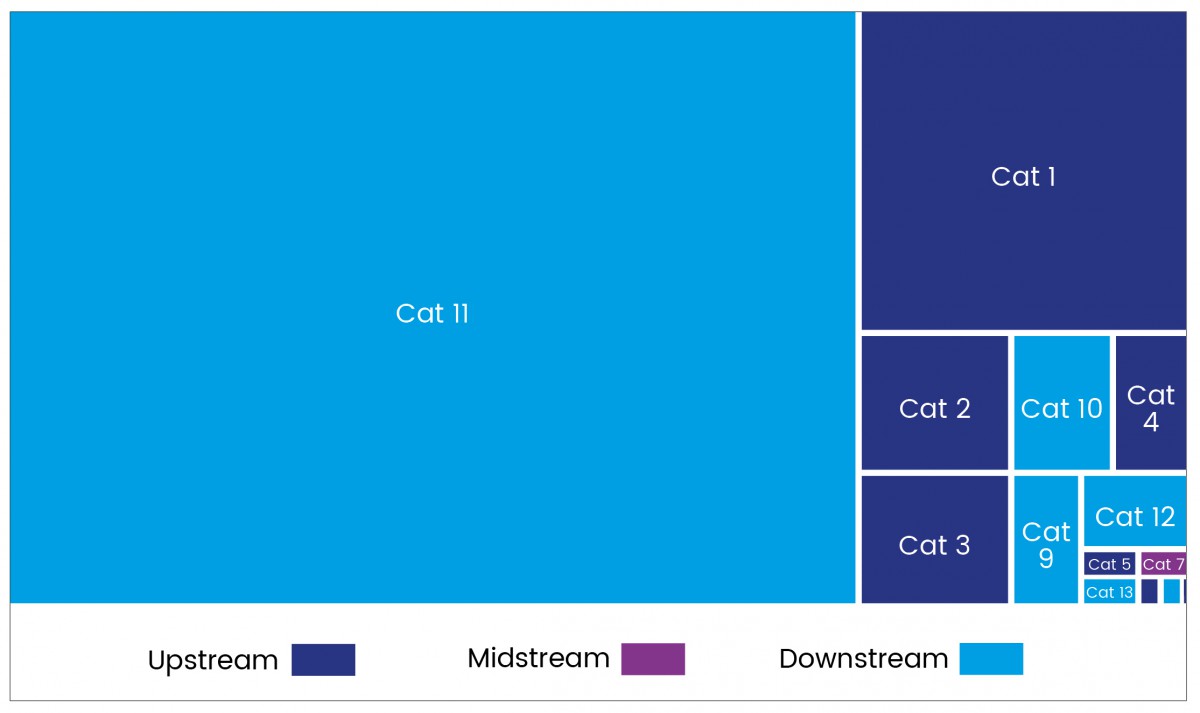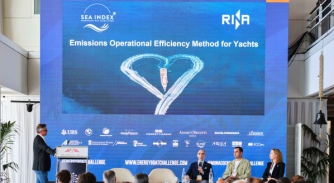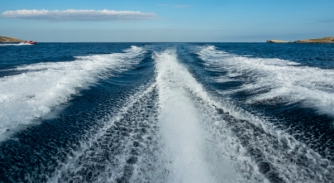Scope 3 emissions – their challenges and potential solutions
As Scope 3 becomes critical to reporting and disclosure regulations, businesses must understand and manage these emissions to future-proof their business…
Carbon accounting is a widely recognised framework for organisations to measure and reduce their greenhouse gas (GHG) emissions. This framework categorises emissions into three scopes: Scope 1 (direct emissions), Scope 2 (indirect emissions) and Scope 3 (emissions associated with the value chain). While Scope 1 and 2 emissions are relatively straightforward, Scope 3 emissions are more complex, encompassing a company’s entire value chain, from suppliers to end users. To help businesses navigate this, the Greenhouse Gas Protocol offers guidance on 15 categories of Scope 3 emissions, covering both upstream and downstream activities.
 The London Stock Exchange Group has estimated the relative quantities of the emissions from these categories (excluding category 15).
The London Stock Exchange Group has estimated the relative quantities of the emissions from these categories (excluding category 15).

If a company measures and tracks emissions in this manner, it will have a ripple effect throughout its value chain. Companies falling into other’s Scope 3 will need to report their emissions to assist in the calculations, and will also face some pressure to reduce their own emissions if the reporting company sets Scope 3 reduction targets. As such, working on emissions and being able to provide both this data and a lower impact compared to a competitor can be advantageous. This is exemplified outside of the industry with Aston Martin, which in its 2022 sustainability report described its implementation of procurement policies to assist in achieving net-zero emissions across the supply chain by 2039, which included a requirement for its suppliers to be compliant with ISO14000:2015. In 2022, 95 per cent of their suppliers reported achieving this.
In 2023, the International Sustainability Standards Board released its first sustainability disclosure standards (IFRS 1 and 2), covering Scope 1, 2 and 3 emissions. This supercedes the climate disclosure recommendations resulting from the Task Force on Climate-Related Financial Disclosure. These standards are becoming a new global baseline, with six countries adopting them (Bangladesh, Brazil, Costa Rica, Nigeria, Kenya and Turkey), 16 planning on adoption (including Australia, Canada, the UK, Japan and China) and three aligning existing regulations to these standards (including the EU and US).
As carbon accounting gains traction through these regulations, so too does the need for accurate information to calculate emissions. Current methods to calculate Scope 3 emissions are based on obtaining directly relevant data or using industry-based average emission factors to multiply the value or quantity/weight of goods/services purchased. Challenges in these have been recognised in documents by the Science-Based Targets Initiative which provides frameworks for companies to set science-based emissions reduction targets that are aligned with the goals of the Paris Agreement. These documents discuss the challenges around Scope 3 emission measuring and target setting, potential solutions and the possible role of environmental attribute certificates (such as carbon credits) in addressing such emissions. The documents precede a draft update to their Corporate Net Zero Standard expected at the end of the year. MASSIV+, an initiative by leading global companies including Microsoft, IKEA and Volvo Cars, aims to overcome the issues of missing information or inaccurate emission multiplication factors, and revolutionise how industries report and validate their GHG emissions and overcome some of the challenges in emissions tracking. Their idea is that if everyone calculated and disclosed their Scope 1 and 2 emissions, it would be possible to calculate Scope 3 emissions more accurately based on this data.
As these regulations and guidelines develop further, and adoption increases of emissions reduction targets, such as the IMO Greenhouse Gas strategy, this will mean that as part of efforts to improve ESG performance, there will be a need to better calculate all the scope emissions. Similar to other ESG requirements, while there may not be a direct need for a business to meet these reporting standards, being a part of another organisation’s value chain who does need to disclose these emissions will also necessitate the ability to provide relevant emissions data. As such, it will be beneficial to be better equipped by developing the capabilities to measure, track and reduce these emissions.
As global efforts to reduce emissions intensify – driven by frameworks like the IMO’s GHG Strategy – businesses will find themselves increasingly required to account for all types of emissions, including those in Scope 3. Even if a company is not directly obligated to meet these reporting standards, being part of another organisation’s value chain will necessitate the ability to provide accurate emissions data. By developing the capability to measure, track and reduce Scope 3 emissions, companies can future-proof their operations, enhance their ESG performance and secure their place in an evolving regulatory landscape.
NEW: Sign up for SuperyachtNewsweek!
Get the latest weekly news, in-depth reports, intelligence, and strategic insights, delivered directly from The Superyacht Group's editors and market analysts.
Stay at the forefront of the superyacht industry with SuperyachtNewsweek
Click here to become part of The Superyacht Group community, and join us in our mission to make this industry accessible to all, and prosperous for the long-term. We are offering access to the superyacht industry’s most comprehensive and longstanding archive of business-critical information, as well as a comprehensive, real-time superyacht fleet database, for just £10 per month, because we are One Industry with One Mission. Sign up here.
Related news

New CO2 emissions tracking tool
Sea Index® and RINA are collaborating on the next addition to their methodology, focusing on the life-cycle impact of fuels, from conventional to biofuels
Crew
-copy.jpg)
Traditional engines, lower emissions
How a new Stage V marine engine provides significant emissions reductions despite being a typical diesel engine
Technology

Is carbon offsetting all it’s cracked up to be?
Our Sustainability Editor explores a new direct air-capture technology and puts the current state of the carbon offsetting industry under the microscope
Crew

New EU directive to increase corporate responsibility
The latest in corporate-justice-related European directives has been agreed, affecting business operations and their negative social and environmental impacts
Business

Carbon pricing explained
Carbon tax is a way to pay for emissions, but what is its future within the maritime and superyacht sectors?
Crew
Related news
New CO2 emissions tracking tool
9 months ago
Traditional engines, lower emissions
9 months ago
Is carbon offsetting all it’s cracked up to be?
10 months ago
New EU directive to increase corporate responsibility
11 months ago
Carbon pricing explained
1 year ago
NEW: Sign up for
SuperyachtNewsweek!
Get the latest weekly news, in-depth reports, intelligence, and strategic insights, delivered directly from The Superyacht Group's editors and market analysts.
Stay at the forefront of the superyacht industry with SuperyachtNewsweek



